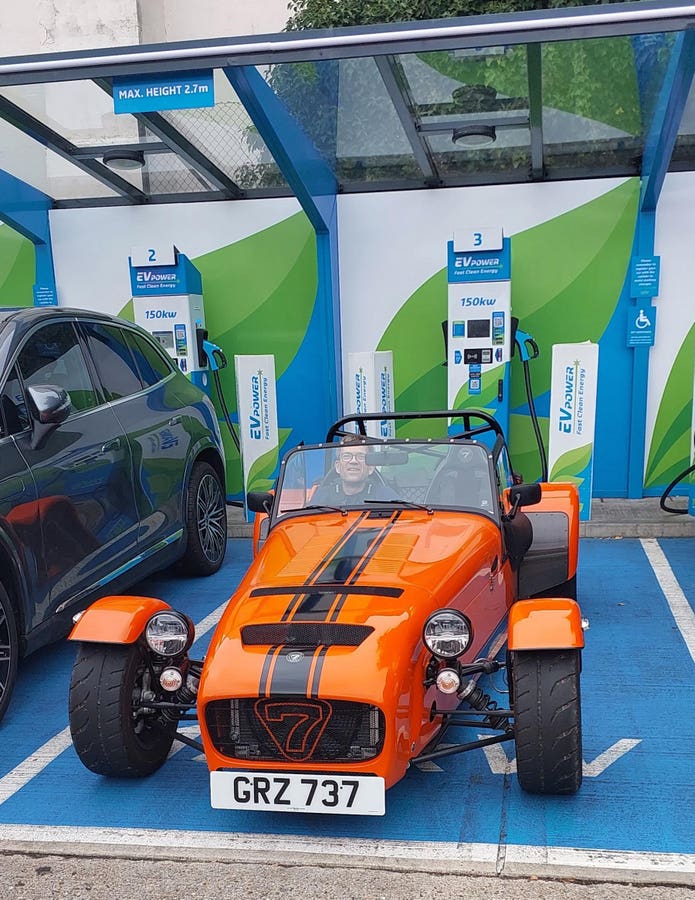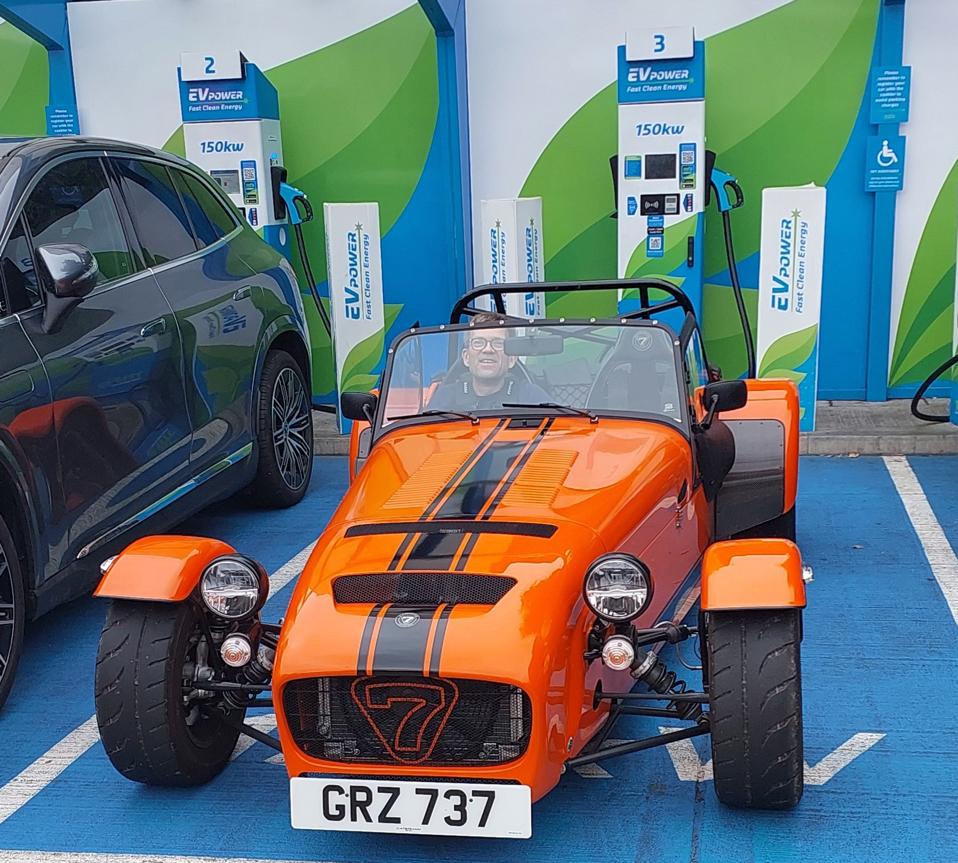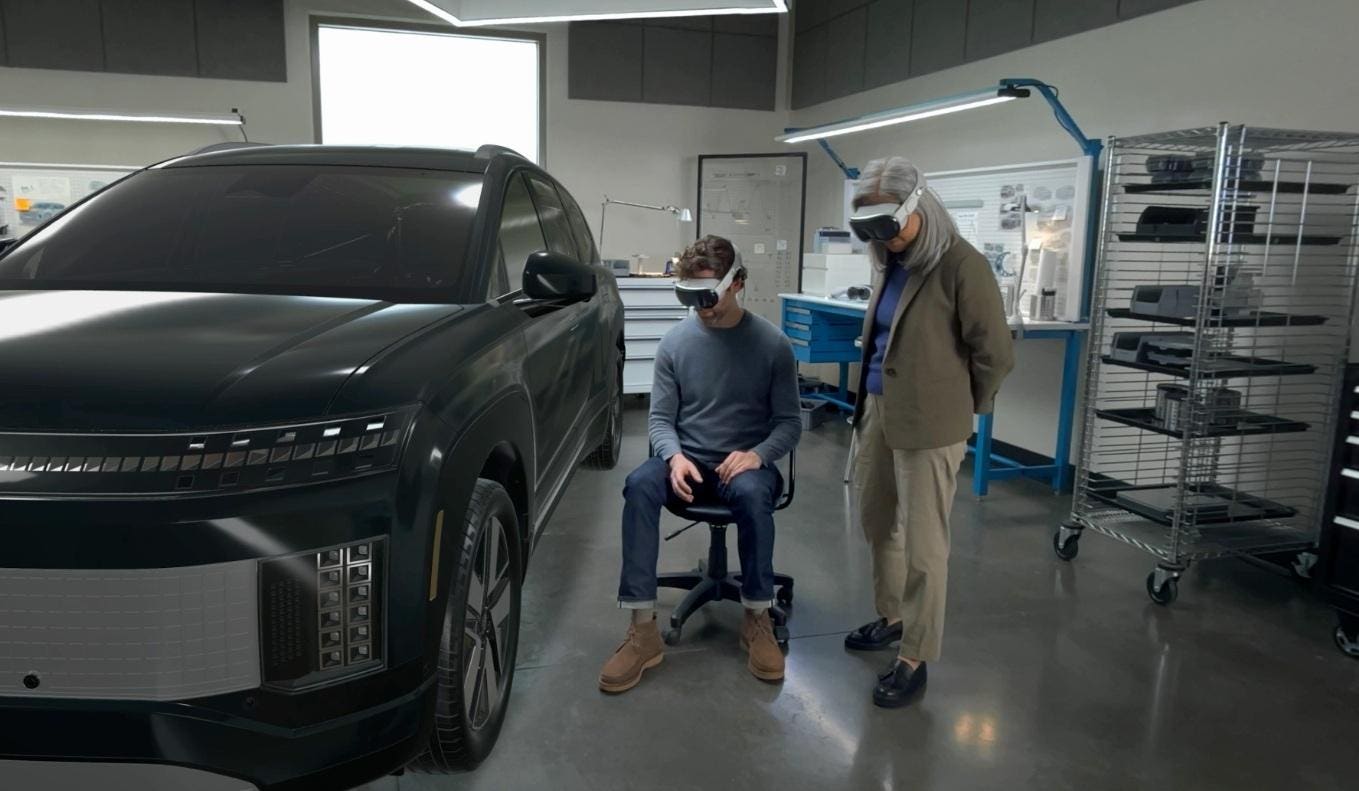Carbesity, carobesity, autobesity… no matter what you call it, cars are getting bigger and heavier, with significant negative consequences for people, cities and the climate. But there are hopeful signs.
Other cars are huge
That is a lasting impression when driving the lightest car that money can buy, the English Caterham Super Seven. In its lightest form it weighs just 440 kilos; not even a fourth of the average new car sold in Europe. We sit almost directly on the ground, the windscreen lower than the wheel arches of most other cars, and a regular parking spot almost fits two of them. It still transports two persons, which is more than what is on average used, it is incredibly fast and hilariously fun. And in times of carbesity it has lessons to share with us.
Not that the Caterham Super Seven is for everyone; while it does have a hood in case it rains, heats up really fast due to the proximity between engine, driver and passenger and even has a heated windscreen, few would use it as their everyday car (yes few, there are those who only have the Seven).
Cars get bigger and heavier
Remember when the Smart was a two-seater city car, parkable everywhere? Well not anymore, its latest offering is a 5 meter long, two meter wide SUV. It may be an extreme example, but cars are getting bigger year by year, on average becoming 1 centimeter wider every two years, as another Forbes previously reported.
The average width of cars is now well over 180cm, incompatible with most parking spaces, while the length is creeping in on 5 meters. There are now more than 150 car models sold in Europe that are too big for public parking, while the average weight of cars sold in Europe has increased by over 20% since 2001.
This trend is true also for electric cars; while in 2017, one-third of EVs on major markets were large cars, pickups or SUVs – it is now over two-thirds. And it may get worse before it gets better; WRI:s compilaton shows that of all new EV models the coming three years, 75% are big.
The key reason for carbesity is not technical requirements but popular demand, primarily for SUV:s and crossovers, which again were the fastest-growing segment in the first half of the year, often Chinese plug-in hybrids. Several European manufacturers try to challenge this, including cheerful upstarts like Microlino but also giants like Stellantis which aims to double its production of electric Citroën, Fiat and Opel microcars, helping them to meet emissions standard. But when looking at their whole range of cars, it too has grown and continues to do so.
In fact, even Caterhams have gotten bigger, but just once — 25 years ago. Then the wide-body version was introduced, with a little more room for legs and elbows. “It’s like buying shoes, you choose the ones that fit”, says Simon Lambert, the CMO (Chief Motorsport Officer before you ask) and head of customer engagement. A favorite story of his is when a well-known brand of executive cars borrowed a Seven for its engineers to understand the benefits of lightness.
The positive spiral of low weight
Low weight equals low energy usage which equals low emissions, with a positive spiral as Caterham will explain. A very light car does not need power steering or power breaking, making it lighter still, and then other components can be lighter too, further reducing material usage and energy consumption. Crucially for Caterham, this makes for more enjoyment too, with the driver in control. “Most modern cars are appliances removing the driver from the drive. We are at the other end of the scale.” This, it seems, is increasingly in demand with sales nudging the company’s self-imposed limit, even though Caterham has decided to stick to their guns and not offer other models than the Super Seven. Some of these are build-it-yourself; the car comes in boxes with the difficult bits preassembled and the rest there for about 80-100 hours of work in a normal garage. You do not save very much by doing so, but your relation with the car grows and at least in theory it opens up for alternative solutions such as going electric. It is also currently the only way they can sell in the US, with its otherwise prohibitively expensive type approval processes.
Small, light and electrifying – an antidote to carbesity
Mattias Goldmann
The brand will stay true to keeping the weight at a minimum and only add things that have a direct purpose, but Simon emphasizes that “not every gram counts” – for instance, there is three kilos of paint on the car which few customers would want without (but again few, not none). The interest of lowering weight can also mean extra income for the manufacturer; when others charge extra for larger tyres, Caterham may well be the only one that has 13’ inch smaller tyres as an option to reduce weight. Details in carbon also reduces weight and adds cost, and “When you are at 500 kilos, evert change makes a huge difference.”
Small = easy to electrify
Remember the early-days EVs? Small commuter cars. Batteries were – and remain – expensive, so it made sense not to use too many, achieved by down-sizing or perhaps right-sizing the car. Then Tesla came and made the EVs desirable, which meant big and heavy. But the basic equation has not changed: The smaller the car, the easier to electrify. This is used to great success by small-car makers such as Swiss-Italian Microlino, whose all-electric is designed around the knowledge that most of the time cars are used by only one or two persons, typically in the city.
All-electric city car Microlino focusing on what most people do most of the time: Drive alone in cities
Mattias Goldmann
The Seven caters for a different customer base at times forgot by the EV community; those that really enjoy driving. Its EV prototypes are currently being shown around the world, receiving high praise for being fast, fun and easy to drive. Adding lightness might just do the trick to convince this section of the market.
Hybrids means bigger and heavier
Why not go plug-in-hybrid, having a combustion engine and an electric motor? It would be a way to meet UK requirements for zero emission capable vehicles by 2030. But in a small, space efficient car, there simply is not room for both combustion and electric parts – and in any car, having two solutions instead of one means added complexity, cost and weight – and with it, higher emissions.
An escape route for Caterham and others that may not have everyone on board to go fully EV by 2030 is to liquify the electricity into e-fuels. The EU is considering to revise the 2035-ban on the combustion engine to include such fuels, provided they are made from green hydrogen and carbon dioxide from the atmosphere. Such e-fuels will be expensive, which makes it logical to use them in energy efficient, light vehicles.
Why does carbesity matter?
You might think that with cars going electric or potentially driving on e-fuels, it doesn’t matter much how big they are. Think again. A bigger car needs more resources, a bigger EV even more so, since it requires larger batteries with more resources in them.
No matter how it is powered, a heavier car also means higher energy consumption, higher emissions and a bigger strain on the grid, and with it poorer air quality due to increased energy production. Furthermore, a heavier car leads to increased release of tyre and brake particles.
You might also, as so many others, feel safer in a bigger car. But bigger cars aren’t safer, according to one study. Heavier vehicles store more kinetic energy, and taller vehicles are more likely to strike pedestrians high, so that they end up under the car rather than in the comparatively benign windscreen. Many accidents in SUV:s come from the driver not being able to see people in front of the car or when turning, with a 45% increased likelihood to cause fatalities in crashes with pedestrians.
On a societal level, bigger cars take up more public space, leaving less room for the livable, likeable city and promote urban sprawl. For cars, big is not beautiful.
Conclusion: How can carbesity be stopped?
Whilst the Caterhams and Microlinos are great fun and even make a lot of sense, they may not be for everyone and they alone will not halt the upsizing trend. But legislation could. Current EU CO2 emission standards do not address vehicle mass, but some countries do. France and Norway have weight-based taxes for cars, with extra allowances for EVs to not punish them for having batteries. Paris triples parking fees for really large cars, the Dutch municipality of Kaatsheuvel has decided to not allow large SUV:s or pick-up trucks where they can be seen – they are not aligned with the image it wants.
Japan has K-cars; tiny in size with engines up to 660 cc and 80 horse powers, and given a host of benefits so powerful even Caterham downsized its already diminutive Seven to meet the requirements.
What do we as conscious consumers want? A weekend with a Seven might give the answer; people are so endeared with small and light they stop you for selfies with the car. Behind the wheel it is all smiles too; lighter really means more fun. Even refilling the car is cheerful; ultralight means ultra-low consumption. Recharging would be an even more positive experience. And if the people at the factory have not registered demand for an electric version previously, well here is my firm expression of interest. But the importance is not whether Caterham does it, it is that others take notice and learn how to go light and stop carbesity.









